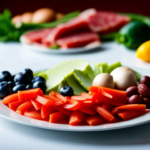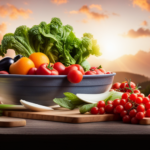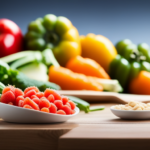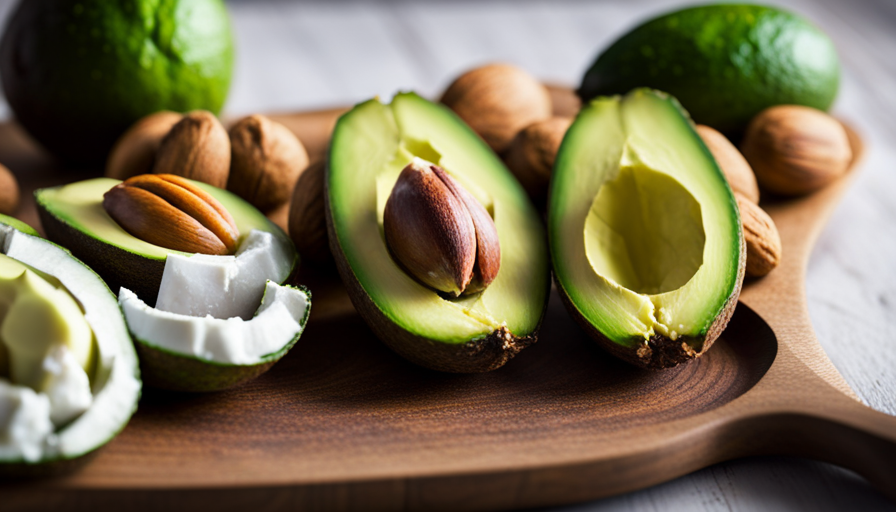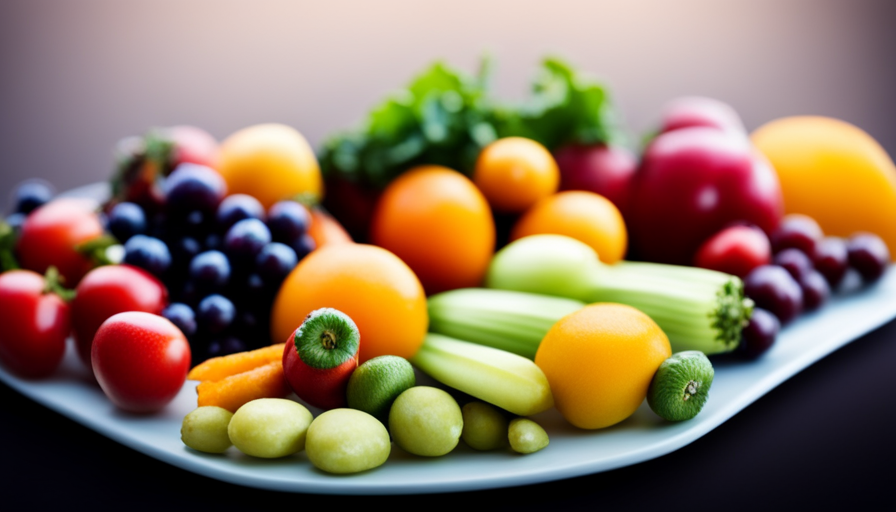You may be wondering, ‘What’s the point of calculating the raw food cost? Can’t I simply purchase what I need and be done with it?’
Well, my friend, let me tell you why it’s crucial to understand the true cost of your ingredients. By determining the raw food cost, you gain a deeper understanding of your spending habits and can make informed decisions about your budget. Plus, it allows you to identify areas where you can save and be more cost-efficient without compromising on the quality of your meals.
In this article, we will guide you through the process of determining raw food costs step by step. We’ll show you how to gather ingredient prices, calculate the cost per serving, consider seasonal options, account for waste, and even take advantage of coupons and discounts.
So, let’s dive in and unlock the secrets to maximizing your savings while still enjoying delicious, wholesome meals.
Key Takeaways
- Determining raw food cost is crucial for understanding spending habits and making budget decisions.
- Tracking expenses, specifically raw food cost, is important for the financial health of a restaurant.
- Knowing the cost of each ingredient helps assess the profitability of menu items and optimize profit margins.
- Understanding raw food cost helps identify areas of waste or shrinkage and allows for corrective measures.
Understanding the Importance of Determining Raw Food Cost
Understanding the importance of determining raw food cost is crucial for achieving a clear and accurate picture of your restaurant’s financial health. Tracking expenses is essential for any business, but in the food industry, where profit margins can be slim, it becomes even more critical.
By accurately determining raw food cost, you can identify any inefficiencies or areas of improvement in your operations.
One of the key reasons why tracking expenses, specifically raw food cost, is important is its direct impact on profitability. Food cost is typically one of the largest expenses for a restaurant, and it can significantly impact the bottom line. By knowing the exact cost of each ingredient, you can better assess the profitability of your menu items. This knowledge allows you to adjust prices, portion sizes, or even change suppliers to optimize your profit margins.
Additionally, understanding raw food cost helps you identify potential areas of waste or shrinkage. By closely monitoring ingredient costs, you can pinpoint any discrepancies or inconsistencies, enabling you to take corrective measures. This could involve implementing better inventory management practices, training staff on portion control, or even reevaluating your menu offerings.
Determining raw food cost is a fundamental aspect of managing a restaurant’s financial health. It allows you to track expenses, optimize profitability, and address any areas of waste or inefficiency. By staying knowledgeable and detail-oriented in your approach, you can ensure your restaurant’s success and sustainability.
Gathering Your Ingredients and Their Prices
To make the process more enjoyable, start by gathering all the ingredients you need and finding out their respective prices. This step is crucial in calculating your raw food cost accurately and efficiently. Here’s a helpful list to guide you through this process:
-
Make a comprehensive list: Begin by listing all the ingredients required for your recipe. This will help you stay organized and ensure that you don’t miss anything.
-
Research prices: Take the time to research the prices of each ingredient at different grocery stores or online platforms. This will allow you to compare prices and find the best deals, ultimately saving you money on groceries.
-
Don’t forget additional costs: In addition to the main ingredients, consider any additional costs such as spices, condiments, or garnishes. These smaller items can add up, so be sure to include them in your calculations.
By following these steps, you’ll have a clear understanding of the cost of each ingredient, enabling you to calculate your raw food cost accurately. Moreover, by researching prices and finding the best deals, you can save money on groceries, making your raw food preparation more cost-effective. Happy gathering!
Calculating the Cost per Serving
Let’s figure out how much each serving will cost you! When it comes to determining the cost per serving for your raw food recipes, accuracy is key. By calculating the cost per serving, you can ensure that you’re getting the most bang for your buck and staying within your budget.
To begin, it’s important to have a clear understanding of portion control. This means knowing the exact amount of each ingredient that goes into a single serving of your dish. By carefully measuring and weighing your ingredients, you can ensure that you’re accurately calculating the cost per serving.
Next, gather the prices of each ingredient used in your recipe. This may require a bit of research, as prices can vary depending on where you shop. Keep track of the cost of each item, making note of any discounts or deals that may affect the final price.
Once you have the portion sizes and ingredient prices, it’s time to do some math. Divide the cost of each ingredient by its portion size to determine the cost per unit. Then, add up the costs of all the ingredients to find the total cost per serving.
By following these steps and paying attention to detail, you can calculate the cost per serving of your raw food recipes with accuracy. This’ll help you make informed decisions about your budget and ensure that you’re getting the most out of your ingredients.
Considering Seasonal and Local Produce
When you shop for ingredients, imagine yourself strolling through a vibrant farmers market, where the colorful array of seasonal and local produce beckons you to create delicious and budget-friendly meals. By considering seasonal and local produce, you not only enhance the flavor and quality of your dishes, but you also reap numerous benefits.
-
Freshness: Seasonal produce is harvested at its peak, ensuring optimal flavor and nutritional value. Local farmers take pride in delivering the freshest ingredients to your table, as they don’t have to travel long distances.
-
Affordability: Seasonal produce tends to be more affordable due to its abundance and reduced transportation costs. By supporting local farmers, you contribute to their livelihoods and help sustain the local economy.
-
Environmental impact: Opting for seasonal and local produce reduces the carbon footprint associated with long-distance transportation. It also promotes sustainable farming practices, as local farmers often prioritize organic and eco-friendly methods.
By incorporating seasonal and local produce into your meals, you not only save money but also support local farmers and enjoy the freshest flavors. So next time you go grocery shopping, embrace the vibrant and diverse selection of seasonal ingredients available and let them inspire your culinary creations.
Factoring in Waste and Leftovers
Considering the environmental impact and the potential for cost savings, it’s important to factor in waste and leftovers when planning meals. Minimizing waste not only helps reduce your carbon footprint but also ensures that you make the most of your ingredients and save money in the process. By repurposing leftovers, you can create delicious meals without having to buy additional ingredients.
One effective way to minimize waste is by meal planning. By planning your meals in advance, you can buy only the necessary ingredients, reducing the chances of buying too much and wasting food. Additionally, you can use a 3-column and 5-row table to keep track of your leftovers and plan creative ways to repurpose them. Here’s an example:
| Leftover Ingredient | Potential Repurpose | Recipe Ideas |
|---|---|---|
| Roasted Chicken | Chicken Salad | Sandwiches, wraps |
| Steamed Vegetables | Stir-fry | Fried rice, noodles |
| Pasta | Pasta Salad | Cold pasta salad |
| Rice | Rice Pudding | Pudding, rice bowls |
| Bread | Croutons | Salads, soups |
By repurposing leftovers, you not only reduce waste but also add variety to your meals. Get creative with your recipes and experiment with different flavors and combinations. By being mindful of waste and utilizing leftovers, you can save money, reduce your environmental impact, and enjoy delicious meals at the same time.
Comparing Prices and Shopping Smart
To save money and make the most of your grocery shopping, you need to compare prices and shop smart. When it comes to determining the raw food cost, comparing brands and finding the best deals is essential.
Start by researching different brands and their prices. Look for sales, discounts, and promotions available at various stores. Don’t be afraid to try different stores to find the best prices for the items you need.
When comparing prices, it’s important to consider the quality of the products. Sometimes a slightly higher price may be worth it if the quality is significantly better. Look for reviews or ask friends and family for their recommendations on different brands. Keep track of the prices you find for each item so that you can easily compare them later.
Another way to shop smart is by purchasing in bulk. Some stores offer discounts for buying larger quantities, which can help you save money in the long run. However, be mindful of the expiration dates and your ability to consume the items before they go bad.
Lastly, take advantage of loyalty programs and coupons. Many stores offer rewards or discounts to regular customers. Look for coupons in newspapers, magazines, or online platforms. Don’t forget to check the store’s website for any digital coupons or promotions available.
By comparing brands and finding the best deals, you can determine the raw food cost and save money on your grocery shopping.
Utilizing Coupons and Discounts
Take advantage of coupons and discounts to maximize your savings while grocery shopping. With the rise of digital coupons, it’s easier than ever to find great deals on the items you need. Here are three strategies to help you make the most of these savings opportunities:
-
Using digital coupons: Many grocery stores now offer digital coupons that can be loaded onto your store loyalty card or accessed through a mobile app. Take advantage of these offers by browsing through the available coupons before you head to the store. Clip the ones for the items on your shopping list and watch the savings add up at the checkout.
-
Maximizing savings: Combine digital coupons with paper coupons to maximize your savings. Look for manufacturer’s coupons in newspapers, magazines, or online coupon databases. Check if your grocery store allows you to stack these coupons with digital ones for even more savings. By taking the time to plan and organize your coupons, you can save a significant amount of money on your grocery bill.
-
Finding discounts on bulk purchases: Another way to save money is by buying in bulk. Look for sales or discounts on larger quantities of the items you use frequently. Stock up on non-perishable items or items that can be frozen to take advantage of these deals. By doing so, you’ll save money in the long run and reduce the number of shopping trips you need to make.
By using digital coupons, maximizing your savings, and finding discounts on bulk purchases, you can significantly reduce your grocery bill. Take the time to explore these strategies and watch your savings grow.
Meal Planning for Cost Efficiency
Planning meals in advance can be a game-changer for saving money on groceries. By incorporating meal planning into your routine, you can ensure that you are making the most budget-friendly choices when it comes to your recipes. Meal prep is a great way to save time and money, as it allows you to prepare multiple meals at once, reducing the need for expensive takeout or last-minute grocery trips.
To get started with meal planning, it’s important to have a variety of budget-friendly recipes in your arsenal. Look for recipes that utilize affordable ingredients, such as beans, rice, and seasonal produce. These ingredients are not only cost-effective but also versatile, allowing you to create a wide range of delicious dishes.
To help you get organized, here is a simple table with three columns and four rows to plan your meals for the week:
| Day | Breakfast | Lunch | Dinner |
|---|---|---|---|
| Monday | Oatmeal | Salad | Stir-fry |
| Tuesday | Smoothie | Sandwich | Pasta |
| Wednesday | Yogurt | Soup | Tacos |
| Thursday | Pancakes | Leftovers | Curry |
By planning your meals in advance and utilizing budget-friendly recipes, you can maximize your savings while still enjoying delicious and nutritious meals. So grab that pen and paper, start meal planning, and watch your grocery bill shrink!
Tracking and Analyzing Your Food Expenses
Keeping track of how much you spend on groceries and analyzing your food expenses can be an eye-opening and empowering experience. By tracking expenses and analyzing costs, you gain valuable insights into your spending habits and can make informed decisions to improve cost efficiency in your meal planning.
Here are four steps to help you effectively track and analyze your food expenses:
-
Create a budget: Start by setting a realistic budget for your groceries. This will give you a benchmark to compare your actual expenses against.
-
Keep receipts: Make it a habit to save all your grocery receipts. This will allow you to have a detailed record of your expenses and help you identify areas where you may be overspending.
-
Categorize expenses: Break down your food expenses into categories such as fruits and vegetables, proteins, dairy, and pantry items. This will help you identify which areas of your grocery shopping are costing you the most.
-
Use technology: Take advantage of budgeting apps or online tools that can help you track and analyze your food expenses. These tools often provide visual representations of your spending patterns, making it easier to identify areas where you can cut costs.
By tracking and analyzing your food expenses, you can gain better control over your spending and make more cost-efficient choices in your meal planning.
Making Adjustments for a Sustainable Food Budget
Now that you’ve tracked and analyzed your food expenses, it’s time to make adjustments for a sustainable food budget. Sustainable eating is not only beneficial for your health but also for the environment. By making conscious choices and adjustments, you can ensure that your raw food costs align with your budget goals while promoting sustainable practices.
One way to make adjustments is by incorporating more plant-based meals into your diet. Plant-based foods tend to be more affordable and can significantly lower your food expenses. Additionally, they have a lower environmental impact compared to animal-based products.
Another adjustment you can make is to plan your meals in advance. This allows you to create a shopping list based on the ingredients you already have, reducing food waste and unnecessary spending. By planning your meals, you can also take advantage of bulk buying opportunities and sales, further lowering your raw food costs.
Furthermore, consider buying local and seasonal produce. Not only is it often fresher and tastier, but it also supports local farmers and reduces transportation emissions. Additionally, buying in bulk from local farmers or joining a community-supported agriculture (CSA) program can provide you with fresh produce at a lower cost.
Making adjustments for a sustainable food budget involves incorporating more plant-based meals, planning meals in advance, and buying local and seasonal produce. By implementing these adjustments, you can not only reduce your raw food costs but also contribute to a more sustainable food system.
Frequently Asked Questions
How can I determine the raw food cost for a specific recipe?
To determine the raw food cost for a specific recipe, start by finding suppliers who offer the ingredients needed at competitive prices. Once you have your suppliers, calculate the portion sizes of each ingredient required for the recipe. This will allow you to accurately estimate the cost of each ingredient per portion.
By considering both the cost of ingredients and the portion sizes, you can determine the raw food cost for your recipe.
What are some tips for finding the best prices for raw ingredients?
To find the best prices for raw ingredients, start by finding suppliers who offer competitive rates.
Comparison shopping is key here. Look for wholesalers or local farmers markets that offer bulk discounts.
Don’t forget to explore online platforms as well, where you can often find great deals.
Be meticulous in your research, comparing prices and quality. By being thorough and analytical in your approach, you can ensure you’re getting the best prices for your raw ingredients.
How do I calculate the cost per serving for a dish?
To calculate the cost per serving for a dish, start by determining the portion size. Divide the total cost of ingredients by the number of servings the recipe makes. This will give you the raw cost per serving.
To calculate the profit margin, subtract the raw cost per serving from the selling price per serving, and divide the result by the selling price per serving. This will help you analyze the profitability of your dish and make informed pricing decisions.
Are there any strategies for reducing food waste and utilizing leftovers?
To reduce food waste and make the most of leftovers, there are several strategies you can employ.
First, plan your meals in advance to avoid overbuying and ensure you use all ingredients.
Get creative with your leftovers by transforming them into new dishes or incorporating them into soups, stir-fries, or salads.
Additionally, proper storage and organization in your fridge and pantry can help prevent food from spoiling.
By adopting these strategies, you can minimize waste and create delicious meals from what you already have on hand.
What are some ways to save money on groceries while still eating healthy?
Want to save money on groceries while still eating healthy? Well, I have some mind-blowing strategies for you.
First off, forget about expensive organic produce and start embracing the wonders of processed foods. Who needs fresh fruits and veggies when you can have a can of spam, right? And don’t even think about shopping at farmers markets, those places are a highway robbery.
Instead, head straight to the discount aisle and stock up on those budget-friendly, preservative-packed goodies. Healthy eating on a budget, here we come!
Does Handling Raw Food Affect the Cost of Raw Food in a Restaurant?
When determining the cost of raw food in a restaurant, it’s important to consider the points for touching raw food. Increased handling of raw ingredients can lead to higher labor costs and potential food waste. Proper training and efficient processes can help minimize the impact on overall food costs.
Conclusion
In conclusion, by following the steps outlined in this article, you can effectively determine the raw food cost for your meals. While it may seem overwhelming at first, with practice and consistency, you’ll become more efficient in calculating and tracking your expenses.
Anticipated objection: "But isn’t this too time-consuming?" While it may take some initial effort, the benefits of knowing your food cost and being able to make adjustments for a sustainable budget far outweigh the time invested.
So, grab a pen, start gathering your ingredients, and take control of your food expenses today!



